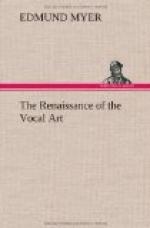The movement from repose to the level of the first tone is highly important, for the reason that it arouses the energies of the singer, and secures all true conditions through automatic form and adjustment. Do not hesitate, do not hurry. All movement must be rhythmical and spontaneous, and never the result of effort. In singing the arpeggio the tones of the voice must be strictly staccato; but the movement of the hands and body must be very smooth, even, and continuous—no short, jerky movements.
The movement of the body is very slight, and at no time, in studying these first exercises, should the hands be raised above the level of the hips or of the waist line. Of course with beginners these movements may be more or less exaggerated. When singing songs, however, they do not show, at least not nearly as much as wrong breathing and wrong effort. They simply give the singer the appearance of proper dignity, position, and self-assertion. By all means use the hands in training the movements of the body. You can train the body by the use of the hands in one-fourth of the time that it is possible to do it without using them. Be careful, however, not to raise the hands too high, as is the tendency; when lifted too high the energy is often put into the hands and arms instead of the body; in this way the body is not properly aroused and influenced, and of course true conditions are not secured.
“Practical rules must rest upon theory, and theory upon nature, and nature is ascertained by observation and experience.” Now, if you will practice this arpeggio with a free, flexible movement of hands and body, getting under the tone, as it were, and moving to a level of every tone, you will soon find by practice and experience that these movements are perfectly natural, that they arouse all the forces which nature gave us for the production of tone, that they vitalize the singer and give freedom to the voice. By moving properly to a level of the first tone you secure all true conditions of tone; and if you have placed yourself properly upon a level with the high tone, when that is reached you will have maintained those true conditions—you will have freedom, inflation and vitality instead of contraction and strain.
By moving with the voice in this flexible manner we bring every part of the body into action, and apply strength as nature demands it, without effort or strain. Remember, there is no strength properly applied in singing without movement. In this way the voice is an outward manifestation of an inward feeling or emotion. “The voice is your inner or higher self, expressed not at or by but through the vocal organs, aided by the whole body as a sound-board.”
Our next study will be a simple arpeggio sung with the la sound, thus:
[Illustration: SECOND STUDY. La....]
This movement, of course, must be sung with the same action of hands and body, starting from repose to the level of the first tone, and keeping constantly upon a level with the voice by ascending and descending. Sing this exercise first semi staccato, afterwards legato.




